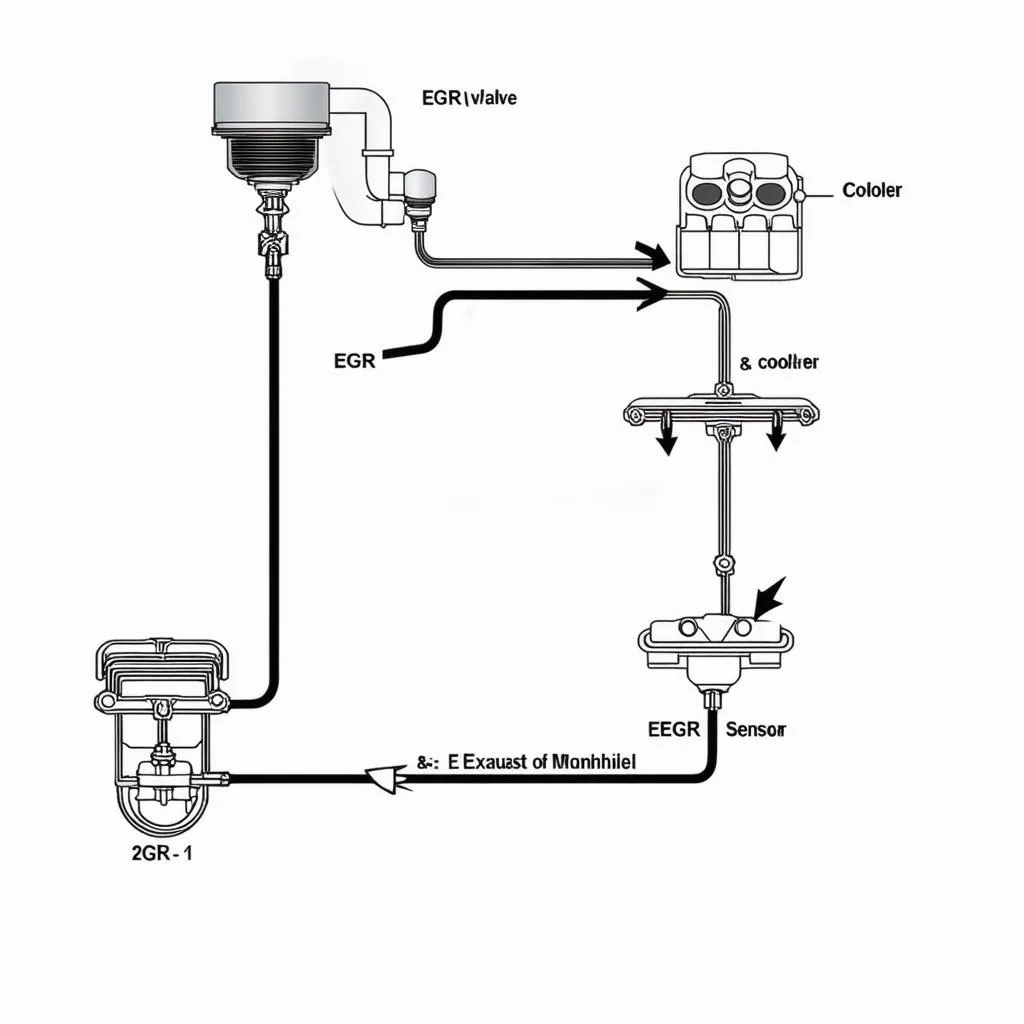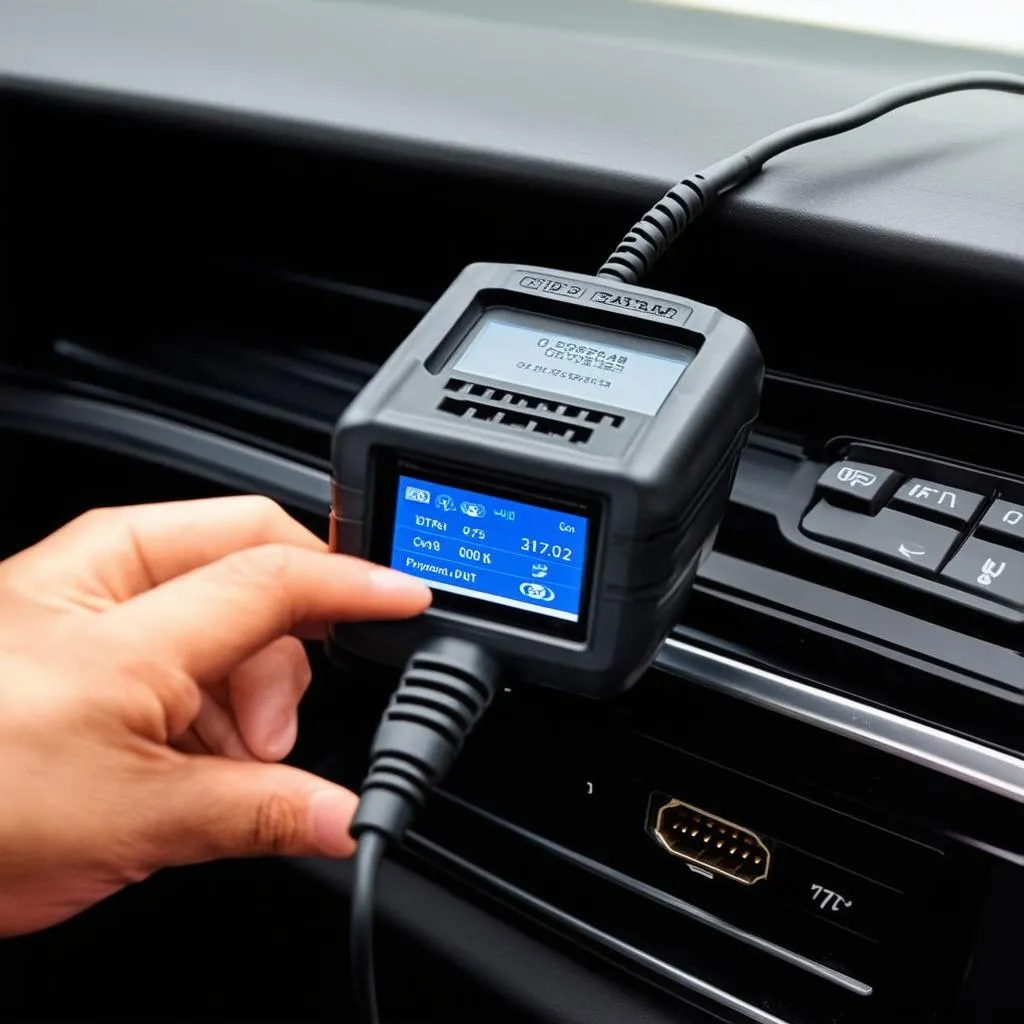Have you ever wondered how to keep your car’s engine running smoothly and efficiently? One vital component that plays a critical role in this process is the Exhaust Gas Recirculation (EGR) system. If your car is experiencing problems, it’s likely that your EGR system needs attention. But how do you monitor this system, especially with an OBD reader? Let’s dive into the fascinating world of automotive diagnostics and explore the ins and outs of using an OBD reader to monitor your car’s EGR system.
Understanding the Importance of EGR System Monitoring
Imagine your car’s engine as a complex, intricate machine with many moving parts. Each part plays a crucial role in ensuring smooth operation. Among these parts, the EGR system stands out as a vital component responsible for reducing harmful emissions and improving fuel efficiency.
 EGR System Diagram
EGR System Diagram
The EGR system works by recirculating a small amount of exhaust gases back into the combustion chamber. This process helps to lower the combustion temperature, reducing the formation of nitrogen oxides (NOx), a harmful pollutant that contributes to smog and acid rain. It also helps improve fuel efficiency by slightly reducing engine power output.
Monitoring Your EGR System with an OBD Reader
Now, let’s talk about the magic of OBD readers. An OBD (On-Board Diagnostics) reader is a handy device that connects to your car’s diagnostic port, allowing you to access various data and information about your vehicle’s performance.
 OBD Reader Connected
OBD Reader Connected
One of the key things you can monitor with an OBD reader is the EGR system. By reading the diagnostic codes, you can identify potential problems and take corrective action. These codes provide valuable insights into the health of your EGR system, revealing whether the EGR valve is functioning correctly, if the EGR flow is within acceptable limits, or if there are any sensor malfunctions.
How to Use an OBD Reader to Monitor the EGR System
Using an OBD reader to monitor your EGR system is relatively straightforward. Here are the basic steps:
- Connect the OBD Reader: Plug the OBD reader into your car’s diagnostic port, usually located beneath the steering wheel or near the dashboard.
- Turn on the Ignition: Turn the ignition key to the “on” position, but don’t start the engine.
- Select EGR Parameters: Navigate through the OBD reader’s menus to find the EGR-related parameters. This may include EGR valve position, EGR flow rate, and EGR system status.
- Read the Data: Monitor the readings on the OBD reader’s display to analyze the EGR system’s performance. Look for any abnormal readings or error codes that might indicate a problem.
- Interpret the Results: Refer to the OBD reader’s manual or online resources to understand the meaning of the codes and readings. If you encounter any errors or unexpected readings, consult a qualified mechanic for professional diagnosis and repair.
Common EGR System Problems You Can Identify with an OBD Reader
Here are some common EGR system issues you can identify using an OBD reader:
- EGR Valve Stuck Open or Closed: This can lead to rough idling, poor fuel economy, and increased emissions.
- EGR Cooler Malfunction: A damaged or clogged EGR cooler can restrict exhaust gas flow, leading to overheating and potential engine damage.
- EGR Sensor Failure: A faulty EGR sensor can provide inaccurate readings to the engine control module (ECM), leading to improper EGR operation.
Tips for Maintaining Your EGR System
- Regularly Inspect the EGR System: Check the EGR valve, EGR cooler, and hoses for any signs of wear, tear, or blockage.
- Use High-Quality Fuel: Using low-quality fuel can lead to carbon buildup in the EGR system, hindering its performance.
- Professional Maintenance: Schedule regular maintenance checks with a qualified mechanic to ensure your EGR system is functioning optimally.
The Spiritual and Feng Shui Connection to Your EGR System
While it may seem unusual, there’s a fascinating connection between your EGR system and spiritual concepts. Think of your car as a microcosm of your life – it needs to be in balance for things to flow smoothly.
- EGR System as a Symbol of Flow: The EGR system’s ability to regulate exhaust gas flow can be viewed as a metaphor for the flow of energy in your life. Just as a blocked EGR system can impede engine performance, imbalances in your life can hinder your progress and well-being.
- Feng Shui and Energy Flow: Feng Shui principles emphasize the importance of maintaining a harmonious flow of energy (chi) in your surroundings. Just as a clogged EGR system can create an imbalance in your car’s engine, disharmony in your home or workplace can affect your energy levels and overall well-being.
By taking care of your EGR system, you’re not only enhancing your car’s performance but also contributing to a smoother, more balanced energy flow in your life.
FAQs:
Q: Can I clean the EGR valve myself?
A: While cleaning the EGR valve is possible for some vehicles, it’s a more complex process than it might seem. The EGR valve is located in a high-heat area, and cleaning it requires specific tools and knowledge. It’s recommended to consult a qualified mechanic for professional cleaning.
Q: How often should I monitor my EGR system with an OBD reader?
A: It’s a good practice to monitor your EGR system regularly, especially if you notice any changes in your car’s performance, such as rough idling, reduced fuel efficiency, or an increase in emissions. If you’re not experiencing any problems, a yearly check using an OBD reader can provide valuable insights into your EGR system’s health.
Q: What are the signs of a bad EGR valve?
A: Here are some common signs of a bad EGR valve:
- Rough idling: The engine may shake or vibrate when idle.
- Reduced fuel efficiency: The car may get fewer miles per gallon than usual.
- Increased emissions: The car may produce excessive smoke or fumes.
- Check engine light: The check engine light may illuminate, indicating a problem with the EGR system.
Q: What are some good OBD reader recommendations?
A: If you’re interested in exploring the world of OBD readers, here are some popular options:
- Autel MaxiCOM MK808
- Launch X431 Pro
- Innova 3100
Q: Where can I find more information on automotive diagnostics and OBD readers?
A: For additional information on automotive diagnostics, OBD readers, and the EGR system, you can visit these resources:
- TechCarUSA – https://techcarusa.com/innova-3100-obd-ii-code-reader-manual/
- OBD-II.com
- Autozone.com
Conclusion
Monitoring your car’s EGR system using an OBD reader can provide valuable insights into its health and performance. By understanding the basics of EGR system operation and using a reliable OBD reader, you can proactively identify potential problems and take corrective action before they escalate into major issues. Remember, maintaining your car’s EGR system is not just about keeping your engine running smoothly but also about promoting a harmonious flow of energy in your life, aligning with the principles of Feng Shui and spiritual well-being.
If you have any questions about monitoring your EGR system with an OBD reader, feel free to leave a comment below or reach out to our team of automotive experts. We’re here to help you keep your car running smoothly and efficiently.
For expert guidance and assistance with your car’s diagnostics, contact us via WhatsApp: +84767531508. Our team of technicians is available 24/7 to provide support and answer your questions.